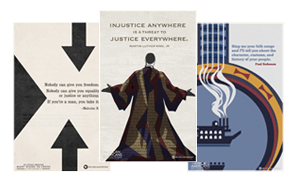’12 Years a Slave’: Trek From Slave to Screen
‘Utter Darkness’

The cast of “12 Years a Slave” and director Steve McQueen (at far right) at the New York Film Festival in October 2013. Photo by Risa Korris.
As a literary scholar and cultural historian who has spent a lifetime searching out African Americans’ lost, forgotten and otherwise unheralded tales, I was honored to serve as a historical consultant on Steve McQueen’s 12 Years a Slave, most certainly one of the most vivid and authentic portrayals of slavery ever captured in a feature film. In its blend of tactile, sensory realism with superb modernistic cinematic techniques, this film is 180 degrees away from Quentin Tarantino’s postmodern spaghetti Western-slave narrative, Django Unchained, occupying the opposite pole on what we might think of as “the scale of representation.”
No story tells itself on its own; even “true” stories have to be recreated within the confines and various formal possibilities for expression offered by a given medium, and that includes both feature films and documentaries, as well. Both of these films offer compelling interpretations of the horrific experience of human bondage, even if their modes of storytelling are diametrically opposed, offering viewers — and especially teachers and students — a rare opportunity to consider how the ways that an artist chooses to tell a story — the forms, points of view and aesthetic stances she or he selects — affects our understanding of its subject matter.
One hundred and sixty years before Steve McQueen made any artistic choices, Solomon Northup, the narrator and protagonist of 12 Years a Slave, was eager just to get his story out to the public — and have them believe that what had happened to him was authentic. Think of what it must have been like for Solomon during those first disorienting hours in the pitch black, when, in “the dungeon” of Williams’ Slave Pen off Seventh Avenue in Washington, D.C., he had to reckon with the betrayal that had lured him out of a lifetime of freedom into a nightmare of bondage. “I found myself alone, in utter darkness, and in chains,” Northup wrote, and “nothing broke the oppressive silence, save the clinking of my chains, whenever I chanced to move. I spoke aloud, but the sound of my own voice startled me.”
Not only was Northup suddenly a stranger to himself, in an even stranger place, but with his money and the papers proving his status as a free black man stolen and a beating awaiting every insistence on the truth, Northup was forced into a horrifying new role, that of the paradoxical “free slave,” under the false name “Platt Hamilton,” a supposed “runaway” from Georgia. That all this happened in the shadows of the U.S. Capitol — that in cuffs Northup was shuffled down the same Pennsylvania Avenue where just over a century later Dr. King would be heard delivering his “Dream” speech, a few decades before President Barack Obama and his wife Michelle would parade in hopes of fulfilling it — must have made Northup’s imposed odyssey taste all the more bitter. “My sufferings,” he recalled of the first whipping he received, “I can compare to nothing else than the burning agonies of hell!”
But unlike Dante’s Inferno, the outpost to which Solomon Northup was forced to descend was no metaphorical space replete with various circles housing the damned, but the swamps, forests and cotton fields in the Deep South. “I never knew a slave to escape with his life from Bayou Boeuf,” Northup wrote. After that, the driving force of his life — and story — could be summed up in one question: Would he be the exception?
Here are the facts.
Who Was Solomon Northup?
Spoiler alert: This section of the column — and only this section — contains some information also covered in the film.
Solomon Northup spent his first 33 years as a free man in upstate New York. He was born in the Adirondack town of Schroon (later Minerva) July 10, 1807 (his memoir says 1808, but the evidence suggests otherwise). As a child, he learned to read and write while assisting his father Mintus, a former slave who eventually bought enough farm land in Fort Edward to qualify for the vote (a right that in many states, during the early days of the Republic, was reserved for landowners). Solomon’s mother, Susannah, was a “quadroon,” who may have been born free herself. Solomon’s “ruling passion,” he said, was “playing on the violin.”
Married at 21, Northup and his wife Anne Hampton (the daughter of a free black man who was also part white and Native American) had three children: Elizabeth, Margaret and Alonzo. In 1834, they settled in Saratoga Springs, where Solomon toiled at various seasonal jobs, including rafting, woodcutting, railroad construction, canal maintenance and repairs, farming and, in resort season, staffing area hotels (for a time, he and his wife both lived and worked at the United States Hotel). His “ruling passion,” the violin, also became a way of earning money, and his reputation grew.
In March 1841, Northup was lured from his home by two white men, using the aliases Merrill Brown and Abram Hamilton, who claimed to be members of a Washington, D.C.-based circus in need of musicians for their sightseeing tour. While in New York City, Brown and Hamilton convinced Northup to journey further South with them, and arriving in Washington, D.C., on April 6, 1841, the trio lodged at Gadsby’s Hotel. The next day, the two men got Northup so drunk (he implied they drugged him) that, in the middle of the night, he was roused from his room by several men urging him to follow them to a doctor. Instead, when Northup came to, he found himself “in chains,” he said, at Williams’ Slave Pen with his money and free papers nowhere to be found. Attempting to plead his case to the notorious slave trader James H. Birch (also spelled “Burch”), Northup was beaten and told he was really a runaway slave from Georgia. The price Birch paid Brown and Hamilton for their catch: $250.
Shipped by Birch on the Orleans under the name “Plat Hamilton” (also spelled “Platt”), Northup arrived in New Orleans on May 24, 1841, and after a bout of smallpox, was sold by Birch’s associate, Theophilus Freeman, for $900. Northup was to spend his 12 years in slavery (actually it was 11 years, 8 months and 26 days) in Louisiana’s Bayou Boeuf region. He had three principal owners: the paternal planter William Prince Ford (1841-1842), the belligerent carpenter John Tibaut (also spelled “Tibeats”) (1842-1843) and the former overseer-turned-small cotton planter Edwin Epps (1843-1853).
Ford gave Northup the widest latitude, working at his mills. Twice Northup and Tibaut came to blows over work, the second time Northup coming so close to choking Tibaut to death (Tibaut had come at him with an ax) that Northup fled into the Great Cocodrie Swamp. Though prone to drink, Edwin Epps was brutally efficient with the lash whenever Northup was late getting to the fields, inexact in his work (Northup had many skills; picking cotton wasn’t one of them), unwilling to whip the other slaves as Epps’ driver or too high on his own talents as a fiddler after Epps purchased him a violin to placate his wife, Mary Epps.
In 1852, Epps hired a Canadian carpenter named Samuel Bass to work on his house. An opponent of slavery, Bass agreed to help Northup by mailing three letters on his behalf to various contacts in New York. Upon receiving theirs, the Saratoga shopkeepers William Perry and Cephas Parker notified Solomon’s wife and attorney Henry Bliss Northup, a relative of Solomon’s father’s former master. With bipartisan support, including a petition and six affidavits, Henry Northup successfully petitioned New York Gov. Washington Hunt to appoint him an agent of rescue. On Jan. 3, 1853, Henry Northup arrived at Epps’ plantation with the sheriff of Avoyelles Parish, La. There was no need for questioning. A local attorney, John Pamplin Waddill, had connected Henry Northup to Bass, and Bass had led him to the slave “Platt.” The proof was in their embrace.
Traveling home, Henry and Solomon Northup stopped in Washington, D.C., on Jan. 17, 1853, to have the slave trader James Birch arrested on kidnapping charges, but because Solomon had no right to testify against a white man, Birch went free. Solomon Northup was reunited with his family in Glens Falls, New York on Jan. 21, 1853.
Over the next three months, he and his white editor, David Wilson, an attorney from Whitehall, N.Y., wrote Northup’s memoir, 12 Years a Slave. It was published July 15, 1853, and sold 17,000 copies in the first four months (almost 30,000 by January 1855). “While abolitionist journals had previously warned of slavery’s dangers to free African-American citizens and published brief accounts of kidnappings, Northup’s narrative was the first to document such a case in book-length detail,” Brad S. Born writes in The Concise Oxford Companion to African American Literature. With its emphasis on authenticity, 12 Years a Slave gave contemporary readers an up-close account of slavery in the South, including the violent tactics owners and overseers used to force slaves to work, and the sexual advances and jealous cruelties slave women faced from their masters and masters’ wives.
Since then, it has been “authentic[ated]” by “[a] number of scholars [who] have investigated judicial proceedings, manuscript census returns, diaries and letters of whites, local records, newspapers and city directories,” wrote the ultimate authority on the authenticity of the slave narratives, the late Yale historian John W. Blassingame, in his definitive 1975 essay, “Using the Testimony of Ex-Slaves: Approaches and Problems,” in The Journal of Southern History.
In 1854, Northup’s book led to the arrest of his original kidnappers, Brown and Hamilton. Their real names, respectively, were Alexander Merrill and James Russell, both New Yorkers. Though Solomon was able to testify at their trial in Saratoga County, the case dragged on for three years and was eventually dropped by the prosecution in 1857, the same year the U.S. Supreme Court handed down its decision in Dred Scott v. Sanford, which, in part, denied black people were citizens of the United States (and thus they could not sue in federal court).
A free man returned from slavery, Solomon Northup remained active in the abolitionist movement; lectured throughout the Northeast; staged, and performed in, two plays based on his story (the second, in 1855, was titled “A Free Slave”); and was known to aid fugitive slaves on the Underground Railroad. To this day, the date, location and circumstances of his death remain a mystery. Northup’s last public appearance was in August 1857 in Streetsville, Ontario, Canada. The last recollected contact with him was a visit to the Rev. John L. Smith, a Methodist minister and fellow Underground Railroad conductor, in Vermont sometime after the Emancipation Proclamation, likely in 1863.
Fifty of the 100 Amazing Facts will be published on The African Americans: Many Rivers to Cross website. Read all 100 Facts on The Root.
Find educational resources related to this program - and access to thousands of curriculum-targeted digital resources for the classroom at PBS LearningMedia.
Visit PBS Learning Media






